Field Study of the Road Stormwater Runoff Bioretention System with Combined Soil Filter Media and Soil Moisture Conservation Ropes in North China
Abstract
:1. Introduction
| Land Cover Type | Region | TSS (mg/L) | COD (mg/L) | TN (mg/L) | TP (mg/L) | Reference |
|---|---|---|---|---|---|---|
| Road | China | 53–1947 | 104–779 | 3.02–18.9 | 0.26–2.94 | [4] |
| US | 9–466 | 19–2280 | / | 0.1–8.2 | [5] | |
| Japan | 60 | 49 | / | / | [6] | |
| Italy | 11–281 | 15–377 | / | / | [7] | |
| Germany | 18.3–3165 | / | / | / | [8] | |
| Grass land | China | 28 | 21 | 4.20 | 0.24 | [9] |
| Roof | China | 43 | 52 | 4.30 | 0.11 | [10] |
| Italy | 0–42 | / | / | / | [7] |
2. Methods
2.1. Study Area
2.2. Design and Construction of the On-Site Bioretention Facilities
2.2.1. Bioretention Structure and Stormwater Treatment Process
2.2.2. Monitoring Methods and Equipment
2.2.3. Challenge Tests
3. Results and Discussion
3.1. Stormwater Purification Performance
3.2. Challenge Test Results of Bioretention Facilities
3.3. Change Patterns of Media Moisture and Temperature
3.4. Change Patterns of the Media Chemical Properties
3.5. Characteristics of the Media Microbial Diversity
3.5.1. Distribution of Microbial Communities
3.5.2. Composition of Microbial Communities
3.6. Redundancy Analysis of Environmental Factors and Microbial Communities
3.7. Preliminary Analysis of Stormwater Purification Mechanisms
4. Conclusions
Supplementary Materials
Author Contributions
Funding
Institutional Review Board Statement
Informed Consent Statement
Data Availability Statement
Conflicts of Interest
References
- Jacobson, C. Identification and quantification of the hydrological impacts of imperviousness in urban catchments: A review. J. Environ. Manag. 2011, 92, 1438–1448. [Google Scholar] [CrossRef] [PubMed]
- SEPA. Environmental Quality Standards for Surface Water (GB3838-2002); State Environmental Protection Administration of the People’s Republic of China: Beijing, China, 2002. (In Chinese) [Google Scholar]
- SEPA. Discharge Standard of Pollutants for Municipal Wastewater Treatment Plant (GB18918-2002); State Environmental Protec-tion Administration of the People’s Republic of China: Beijing, China, 2002. (In Chinese) [Google Scholar]
- Zhang, N.; Zhao, L.; Li, T.; Jin, Z. Characteristics of pollution and monitoring of water quality in Tianjin. Ecol. Environ. Sci. 2009, 19, 2127–2131. (In Chinese) [Google Scholar]
- Han, Y.; Lau, S.L.; Kayhanian, M.; Stenstrom, M.K. Characteristics of highway stormwater runoff. Water Environ. Res. 2006, 78, 2377–2388. [Google Scholar] [CrossRef] [PubMed]
- Tanaka, Y.; Matsuda, T.; Shimizu, Y.; Matsui, S.; Lee, B.C. A new installation for treatment of road runoff: Up-flow filtration by porous polypropylene media. Water Sci. Technol. 2005, 52, 225–232. [Google Scholar] [CrossRef]
- Gnecco, I.; Berretta, C.; Lanza, L.G.; La Barbera, P. Storm water pollution in the urban environment of Genoa, Italy. Atmos. Res. 2005, 77, 60–73. [Google Scholar] [CrossRef]
- Helmreich, B.; Hilliges, R.; Schriewer, A.; Horn, H. Runoff pollutants of a highly trafficked urban road--correlation analysis and seasonal influences. Chemosphere 2010, 80, 991–997. [Google Scholar] [CrossRef]
- Xie, J.; Hu, Z.; Xu, T.; Han, H.; Yin, D. Water quality characteristics of rainfall runoff in Hefei City. China Environ. Sci. 2012, 32, 1018–1025. (In Chinese) [Google Scholar]
- Wang, S.; He, Q.; Ai, H.; Wang, Z.; Zhang, Q. Pollutant concentrations and pollution loads in stormwater runoff from different land uses in Chongqing. J. Environ. Sci. 2013, 25, 502–510. [Google Scholar] [CrossRef]
- Davis, A. Green Engineering Principles Promote Low-impact Development. Environ. Sci. Technol. 2005, 39, 338A–344A. [Google Scholar] [CrossRef] [Green Version]
- Jia, H.; Yao, H.; Tang, Y.; Yu, S.L.; Field, R. LID-BMPs planning for urban runoff control and the case study in China. J. Environ. Manag. 2015, 149, 65–76. [Google Scholar] [CrossRef]
- Jia, H.; Wang, Z.; Zhen, X.; Clar, M.; Yu, S.L. China’ s sponge city construction: A discussion on technical approaches. Front. Environ. Sci. Eng. 2017, 11, 18. [Google Scholar] [CrossRef]
- Li, Q.; Wang, F.; Yu, Y.; Huang, Z.; Li, M.; Guan, Y. Comprehensive performance evaluation of LID practices for the sponge city construction: A case study in Guangxi, China. J. Environ. Manag. 2019, 231, 10–20. [Google Scholar] [CrossRef] [PubMed]
- Jia, H.; Yao, H.; Tang, Y.; Yu, S.L.; Zhen, J.X.; Lu, Y. Development of a multi-criteria index ranking system for urban runoff best management practices (BMPs) selection. Environ. Monit. Assess 2013, 185, 7915–7933. [Google Scholar] [CrossRef] [PubMed]
- Lopez-Ponnada, E.V.; Lynn, T.J.; Ergas, S.J.; Mihelcic, J.R. Long-term field performance of a conventional and modified bioretention system for removing dissolved nitrogen species in stormwater runoff. Water Res. 2020, 170, 115336. [Google Scholar] [CrossRef] [PubMed]
- Li, L.; Davis, A.P. Urban stormwater runoff nitrogen composition and fate in bioretention systems. Environ. Sci. Technol. 2014, 48, 3403–3410. [Google Scholar] [CrossRef] [PubMed]
- Palmer, E.T.; Poor, C.J.; Hinman, C.; Stark, J.D. Nitrate and phosphate removal through enhanced bioretention media: Mesocosm study. Water Environ. Res. 2013, 85, 823–832. [Google Scholar] [CrossRef] [PubMed]
- Xiong, J.; Ren, S.; He, Y.; Wang, X.C.; Bai, X.; Wang, J.; Dzakpasu, M. Bioretention cell incorporating Fe-biochar and saturated zones for enhanced stormwater runoff treatment. Chemosphere 2019, 237, 124424. [Google Scholar] [CrossRef]
- Singh, R.; Zhao, F.; Ji, Q.; Saravanan, J.; Fu, D. Design and Performance Characterization of Roadside Bioretention Systems. Sustainability 2019, 11, 2040. [Google Scholar] [CrossRef] [Green Version]
- Muerdter, C.; Özkök, E.; Li, L.; Davis, A.P. Vegetation and Media Characteristics of an Effective Bioretention Cell. J. Sustain. Water Built Environ. 2016, 2, 04015008. [Google Scholar] [CrossRef]
- Bratieres, K.; Fletcher, T.D.; Deletic, A.; Zinger, Y. Nutrient and sediment removal by stormwater biofilters: A large-scale design optimisation study. Water Res. 2008, 42, 3930–3940. [Google Scholar] [CrossRef]
- Wu, J.; Cao, X.; Zhao, J.; Dai, Y.; Cui, N.; Li, Z.; Cheng, S. Performance of biofilter with a saturated zone for urban stormwater runoff pollution control: Influence of vegetation type and saturation time. Ecol. Eng. 2017, 105, 355–361. [Google Scholar] [CrossRef]
- Ashoori, N.; Teixido, M.; Spahr, S.; LeFevre, G.H.; Sedlak, D.L.; Luthy, R.G. Evaluation of pilot-scale biochar-amended woodchip bioreactors to remove nitrate, metals, and trace organic contaminants from urban stormwater runoff. Water Res. 2019, 154, 1–11. [Google Scholar] [CrossRef] [PubMed]
- O’Neill, S.W.; Davis, A.P. Water Treatment Residual as a Bioretention Amendment for Phosphorus. II: Long-Term Column Studies. J. Environ. Eng. 2012, 138, 328–336. [Google Scholar] [CrossRef]
- Glaister, B.J.; Fletcher, T.D.; Cook, P.L.; Hatt, B.E. Co-optimisation of phosphorus and nitrogen removal in stormwater biofil-ters: The role of filter media, vegetation and saturated zone. Water Sci. Technol. 2014, 69, 1961–1969. [Google Scholar] [CrossRef]
- Turk, R.P.; Kraus, H.T.; Hunt, W.F.; Carmen, N.B.; Bilderback, T.E. Nutrient Sequestration by Vegetation in Bioretention Cells Receiving High Nutrient Loads. J. Environ. Eng. 2017, 143, 06016009. [Google Scholar] [CrossRef]
- Liu, J.; Sample, D.J.; Owen, J.S.; Li, J.; Evanylo, G. Assessment of selected bioretention blends for nutrient retention using mesocosm experiments. J. Environ. Qual. 2014, 43, 1754–1763. [Google Scholar] [CrossRef]
- Lim, F.Y.; Neo, T.H.; Guo, H.; Goh, S.Z.; Ong, S.L.; Hu, J.; Lee, B.C.Y.; Ong, G.S.; Liou, C.X. Pilot and Field Studies of Modular Bioretention Tree System with Talipariti tiliaceum and Engineered Soil Filter Media in the Tropics. Water 2021, 13, 817. [Google Scholar] [CrossRef]
- Zhao, Y.; Li, Q.; Chen, Z.; Zhou, G.; Jia, H. Optimization of bioretention facility media for municipal road runoff pollution control based on multi-objective evaluation. Water Resour. Prot. 2021, 37, 96–101. (In Chinese) [Google Scholar]
- Xu, D.; Lee, L.Y.; Lim, F.Y.; Lyu, Z.; Zhu, H.; Ong, S.L.; Hu, J. Water treatment residual: A critical review of its applications on pollutant removal from stormwater runoff and future perspectives. J. Environ. Manag. 2020, 259, 109649. [Google Scholar] [CrossRef]
- Guo, H.; Zhou, G.; Zhao, Y.; Zhan, J.; Li, Q.; Jia, H. Experimental study on soil moisture conservation and nitrogen removal of the modified bioretention facility. Water Wastewater Eng. 2021, 47, 66–71. (In Chinese) [Google Scholar]
- Goh, H.W.; Lem, K.S.; Azizan, N.A.; Chang, C.K.; Talei, A.; Leow, C.S.; Zakaria, N.A. A review of bioretention components and nutrient removal under different climates-future directions for tropics. Environ. Sci. Pollut. Res. 2019, 26, 14904–14919. [Google Scholar] [CrossRef] [PubMed]
- MOHURD. Engineering Technical Code for Rain Utilization in Building and Sub-District (GB50400-2016); Ministry of Housing and Urban-Rural Development of the People’s Republic of China: Beijing, China, 2016. (In Chinese)
- SAMR. Reuse of Urban Recycling Water-Water Quality Standard for Urban Miscellaneous Use (GB/T 18920-2020); State Administration for Market Regulation of the People’s Republic of China: Beijing, China, 2020. (In Chinese) [Google Scholar]
- Sungji, K.; Jiwon, L.; Kyungik, G. Inflow and outflow event mean concentration analysis of contaminants in bioretention facilities for non-point pollution management. Ecol. Eng. 2020, 147, 105757. [Google Scholar] [CrossRef]
- Cao, Q.; Song, X.; Wu, H.; Gao, L.; Liu, F.; Yang, S.; Zhang, G. Mapping the response of volumetric soil water content to an intense rainfall event at the field scale using GPR. J. Hydrol. 2020, 583, 124605. [Google Scholar] [CrossRef]
- Zuo, X.; Guo, Z.; Wu, X.; Yu, J. Diversity and metabolism effects of microorganisms in bioretention systems with sand, soil and fly ash. Sci. Total Environ. 2019, 676, 447–454. [Google Scholar] [CrossRef] [PubMed]
- Yu, W.; Lawrence, N.C.; Sooksa-nguan, T.; Smith, S.D.; Tenesaca, C.; Howe, A.C.; Hall, S.J. Microbial linkages to soil biogeochemical processes in a poorly drained agricultural ecosystem. Soil Biol. Biochem. 2021, 156, 108228. [Google Scholar] [CrossRef]
- Li, Y.; Yang, Y.; Zhang, J.; Zhang, Z.; Li, J. Experimental Study on the Effect of the Physicochemical Properties of Contaminated Fillers in Bioretention System on Microbial Community Structure. Water Air Soil Pollut. 2021, 232, 1–16. [Google Scholar] [CrossRef]
- Collins, K.A.; Lawrence, T.J.; Stander, E.K.; Jontos, R.J.; Kaushal, S.S.; Newcomer, T.A.; Grimm, N.B.; Cole Ekberg, M.L. Opportunities and challenges for managing nitrogen in urban stormwater: A review and synthesis. Ecol. Eng. 2010, 36, 1507–1519. [Google Scholar] [CrossRef]
- Davis, A.P.; Hunt, W.F.; Traver, R.G.; Clar, M. Bioretention Technology: Overview of Current Practice and Future Needs. J. Environ. Eng. 2009, 135, 109–117. [Google Scholar] [CrossRef]
- Hunt, W.F.; Smith, J.T.; Jadlocki, S.J.; Hathaway, J.M.; Eubanks, P.R. Pollutant removal and peak flow mitigation by a bioretention cell in urban Charlotte, NC. J. Environ. Eng. -Asce 2008, 134, 403–408. [Google Scholar] [CrossRef]
- Qiu, F.; Zhao, S.; Zhao, D.; Wang, J.; Fu, K. Enhanced nutrient removal in bioretention systems modified with water treatment residuals and internal water storage zone. Environ. Sci. Water Res. Technol. 2019, 5, 993–1003. [Google Scholar] [CrossRef]
- Wagner, M.; Loy, A. Bacterial community composition and function in sewage treatment systems. Curr. Opin. Biotechnol. 2002, 13, 218–227. [Google Scholar] [CrossRef]
- Xing, W.; Li, D.; Li, J.; Hu, Q.; Deng, S. Nitrate removal and microbial analysis by combined micro-electrolysis and autotrophic denitrification. Bioresour. Technol. 2016, 211, 240–247. [Google Scholar] [CrossRef] [PubMed]
- Kragelund, C.; Levantesi, C.; Borger, A.; Thelen, K.; Eikelboom, D.; Tandoi, V.; Kong, Y.; van der Waarde, J.; Krooneman, J.; Rossetti, S.; et al. Identity, abundance and ecophysiology of filamentous Chloroflexi species present in activated sludge treatment plants. FEMS Microbiol. Ecol. 2007, 59, 671–682. [Google Scholar] [CrossRef] [PubMed] [Green Version]
- Waller, L.J.; Evanylo, G.K.; Krometis, L.H.; Strickland, M.S.; Wynn-Thompson, T.; Badgley, B.D. Engineered and Environmental Controls of Microbial Denitrification in Established Bioretention Cells. Environ. Sci. Technol. 2018, 52, 5358–5366. [Google Scholar] [CrossRef] [PubMed]
- Li, M.; Wei, D.; Zhang, Z.; Fan, D.; Du, B.; Zeng, H.; Li, D.; Zhang, J. Enhancing 2,6-dichlorophenol degradation and nitrate removal in the nano-zero-valent iron (nZVI) solid-phase denitrification system. Chemosphere 2021, 287, 132249. [Google Scholar] [CrossRef] [PubMed]
- Wang, H.; He, Q.; Chen, D.; Wei, L.; Zou, Z.; Zhou, J.; Yang, K.; Zhang, H. Microbial community in a hydrogenotrophic denitrification reactor based on pyrosequencing. Appl. Microbiol. Biotechnol. 2015, 99, 10829–10837. [Google Scholar] [CrossRef] [PubMed]
- Hong, J.; Geronimo, F.K.; Choi, H.; Kim, L.H. Impacts of nonpoint source pollutants on microbial community in rain gardens. Chemosphere 2018, 209, 20–27. [Google Scholar] [CrossRef]
- Daims, H.; Lebedeva, E.V.; Pjevac, P.; Han, P.; Herbold, C.; Albertsen, M.; Jehmlich, N.; Palatinszky, M.; Vierheilig, J.; Bulaev, A.; et al. Complete nitrification by Nitrospira bacteria. Nature 2015, 528, 504–509. [Google Scholar] [CrossRef]
- You, Z.; Zhang, L.; Pan, S.Y.; Chiang, P.C.; Pei, S.; Zhang, S. Performance evaluation of modified bioretention systems with alkaline solid wastes for enhanced nutrient removal from stormwater runoff. Water Res. 2019, 161, 61–73. [Google Scholar] [CrossRef]
- Zhao, X.; Huang, J.; Lu, J.; Sun, Y. Study on the influence of soil microbial community on the long-term heavy metal pollution of different land use types and depth layers in mine. Ecotoxicol. Environ. Saf. 2019, 170, 218–226. [Google Scholar] [CrossRef]
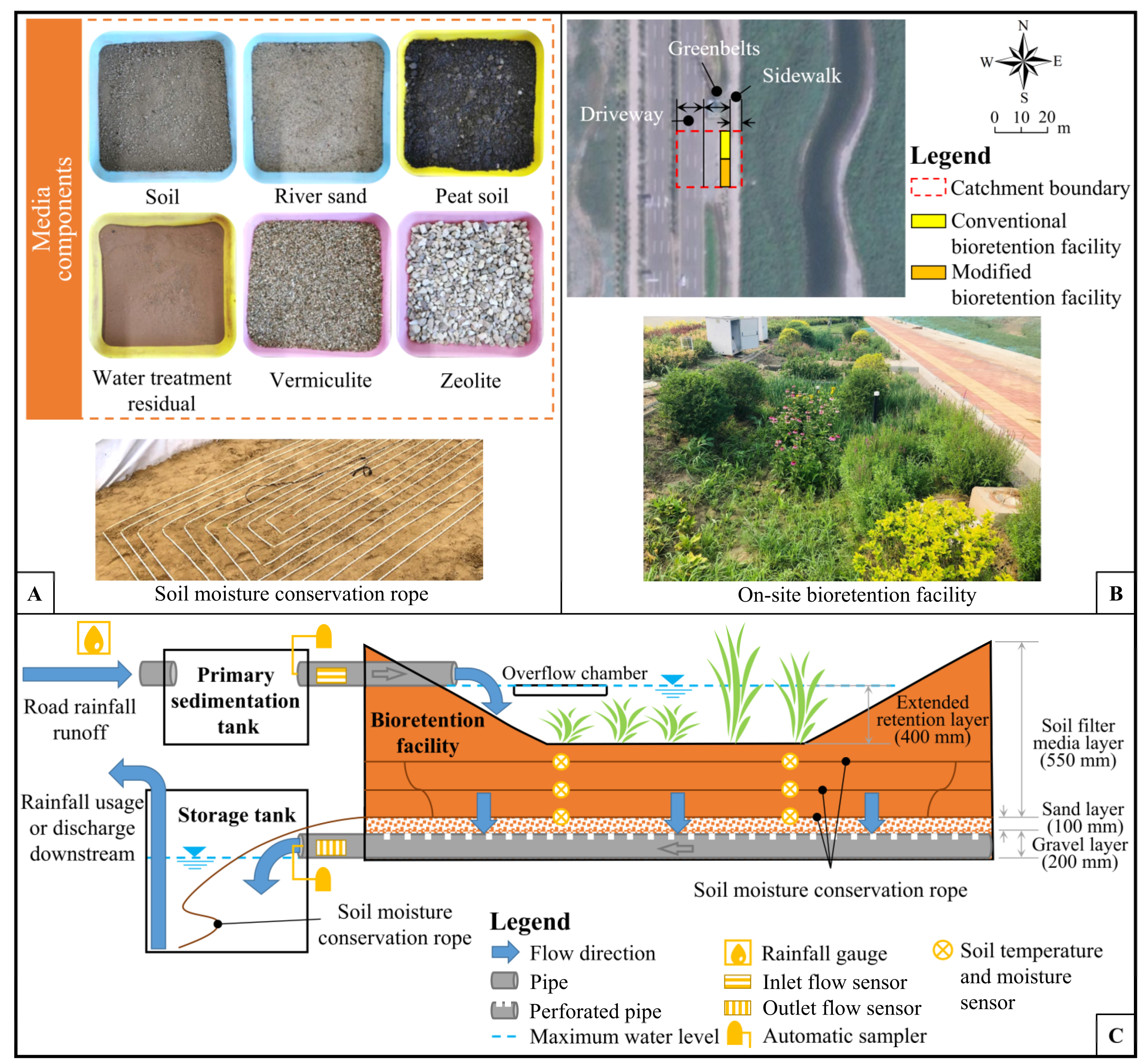


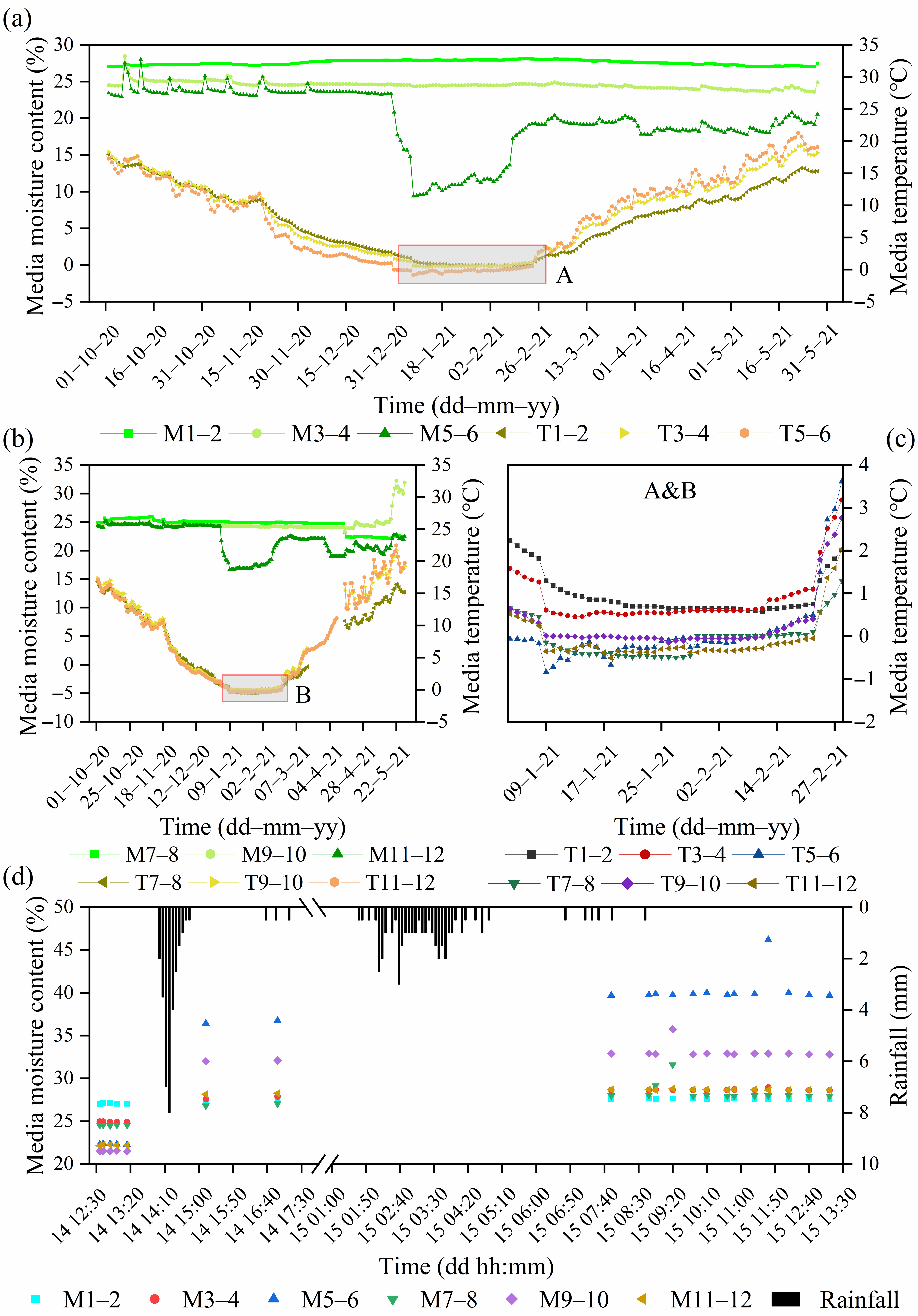

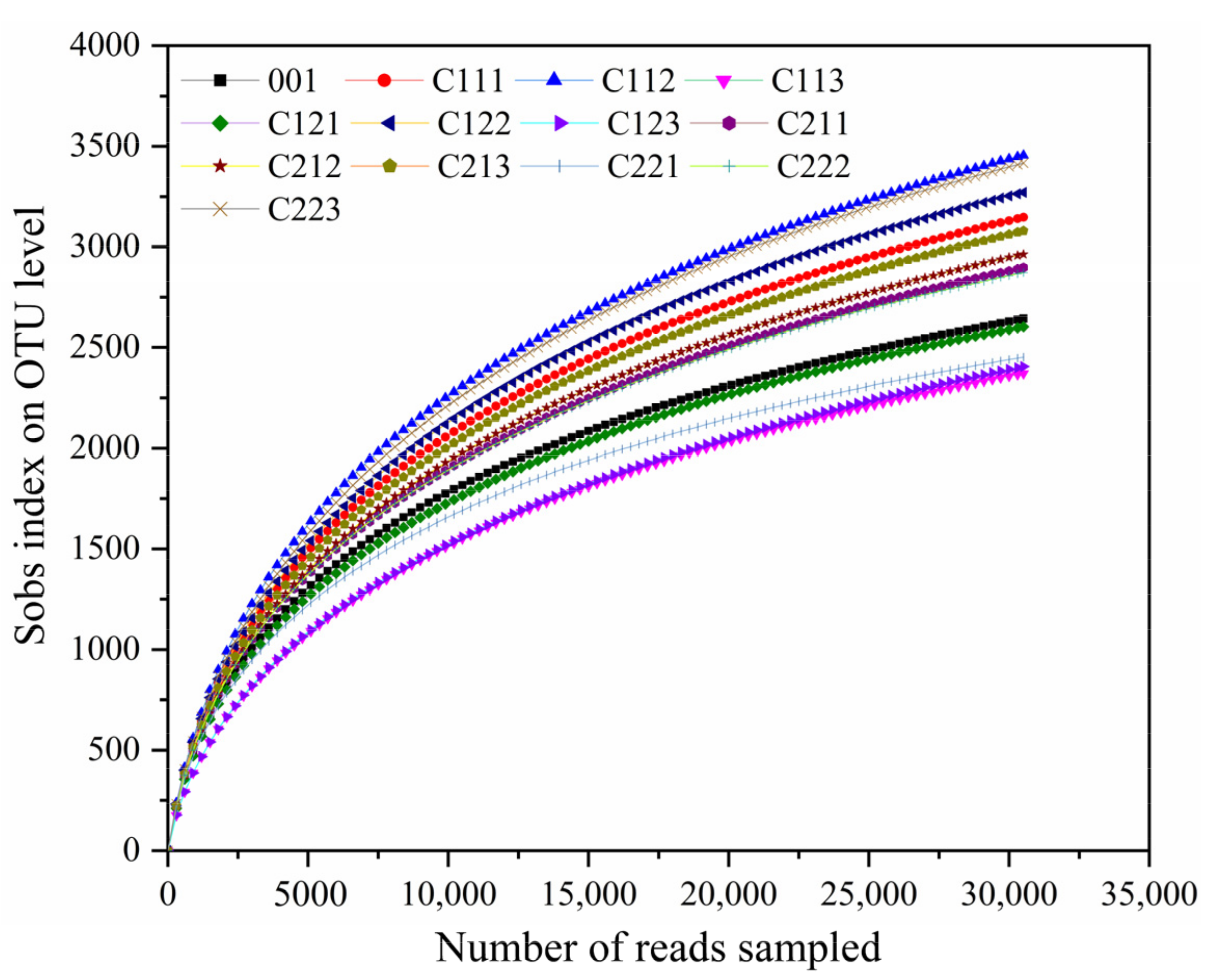
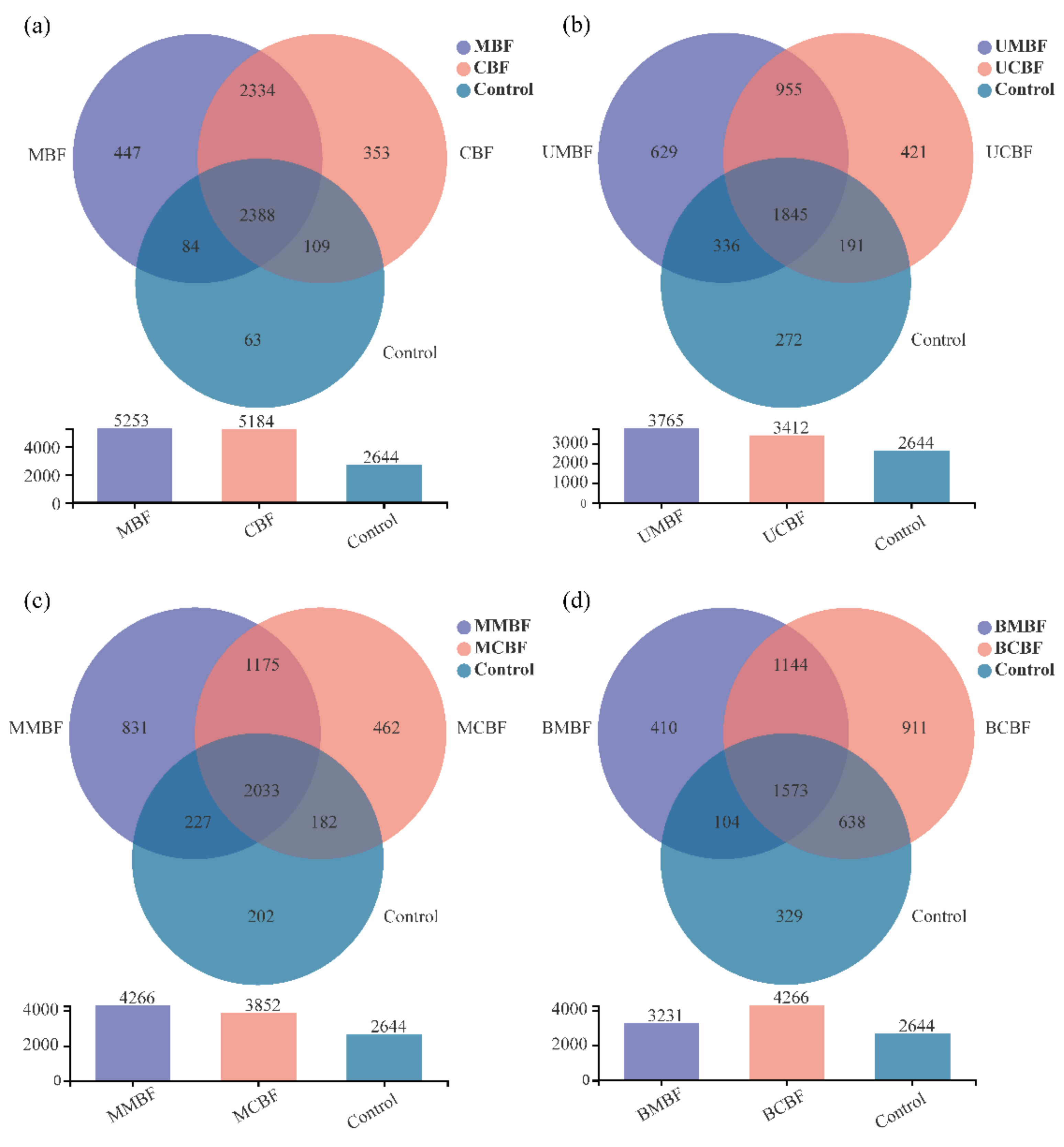
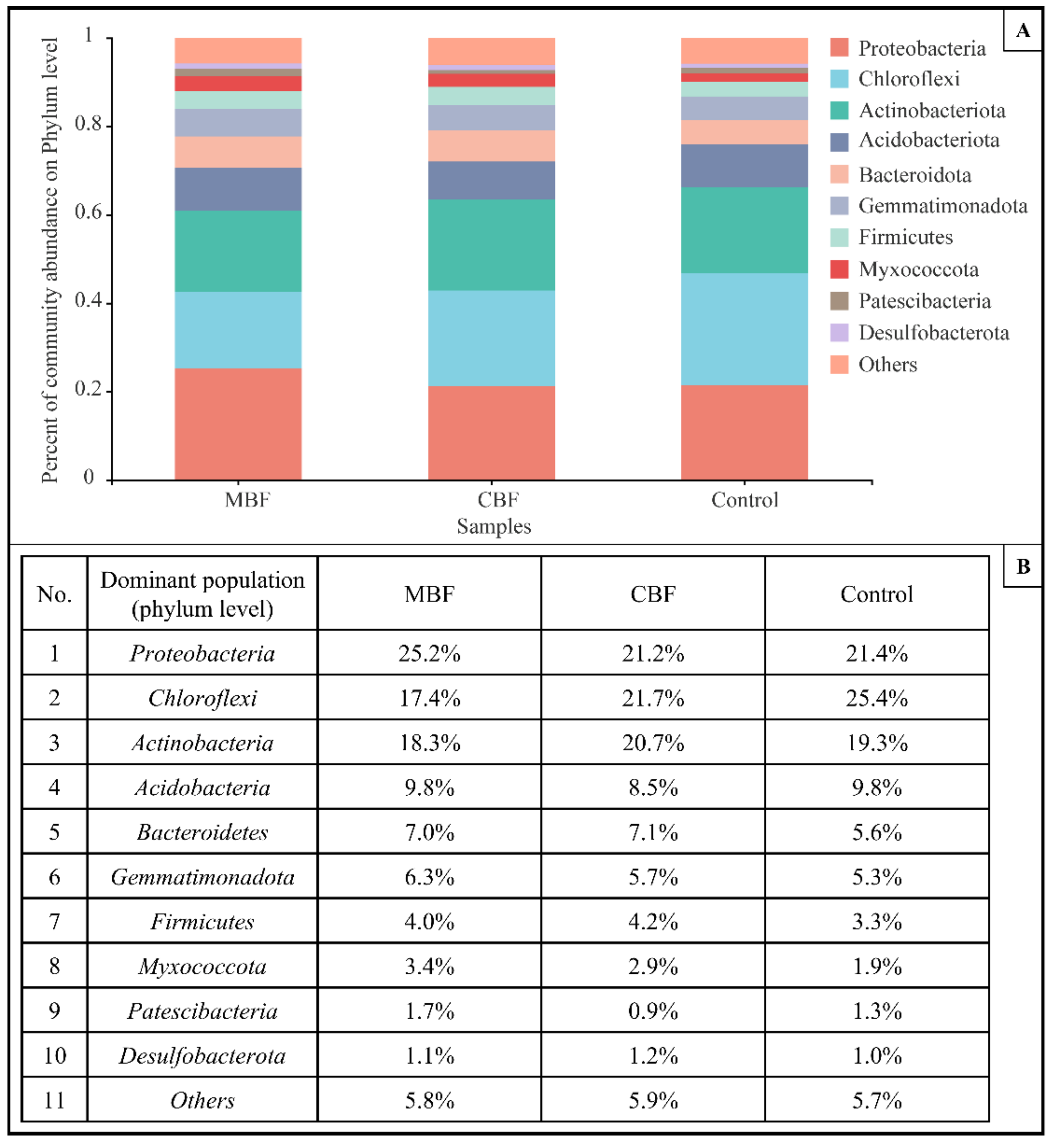
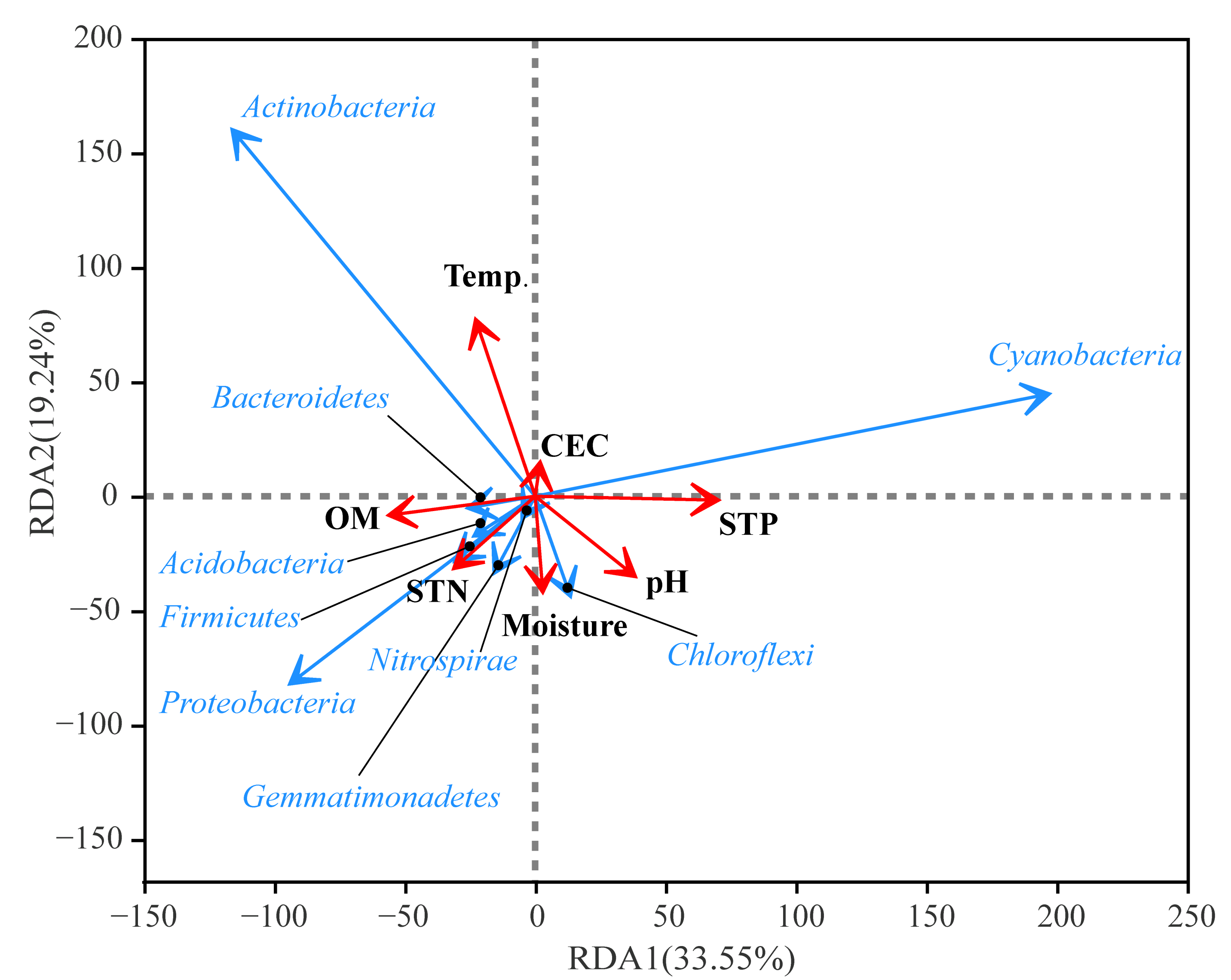
| Item | Area (m2) |
|---|---|
| Bioretention facility | 110 |
| Driveway | 456 |
| Sidewalk | 190 |
| Greenbelts | 346 |
| Total | 1102 |
| Media Type | Particle Size (mm) | Dry Density (kg/m3) | Porosity (%) |
|---|---|---|---|
| Natural soil | <0.5 | 1.15 | 52.2 |
| River sand | 0.06–0.5 | 1.20 | 39.5 |
| Peat soil | 1–5 | 0.61 | 54.6 |
| Vermiculite | 0.5–1 | 0.33 | 65.5 |
| Zeolite | 5–10 | 0.93 | 51.8 |
| Water treatment residual | <0.01 | 0.65 | 25.5 |
| Water Quality Parameter | Targeted Influent Pollutant Concentration |
|---|---|
| TSS | 150 mg/L |
| TP | 1 mg/L |
| TN | 6 mg/L |
| NH3-N | 2 mg/L |
| CODCr | 100 mg/L |
| Water Quality Parameter | Influent (mg/L) | Effluent EMC (mg/L) | Removal Efficiency (%) | ||
|---|---|---|---|---|---|
| MBF | CBF | MBF | CBF | ||
| TSS | 595 | 224 | 212 | 62.4% | 64.4% |
| TN | 8.70 | 3.53 | 3.91 | 59.4% | 55.1% |
| NH3-N | 2.31 | 0.68 | 0.57 | 70.6% | 75.3% |
| NO3-N | 1.02 | 1.72 | 2.45 | −68.6% | −140.2% |
| TP | 1.01 | 0.34 | 0.30 | 66.3% | 70.3% |
| CODCr | 422 | 92 | 89 | 78.2% | 78.9% |
Publisher’s Note: MDPI stays neutral with regard to jurisdictional claims in published maps and institutional affiliations. |
© 2022 by the authors. Licensee MDPI, Basel, Switzerland. This article is an open access article distributed under the terms and conditions of the Creative Commons Attribution (CC BY) license (https://creativecommons.org/licenses/by/4.0/).
Share and Cite
Li, Q.; Jia, H.; Guo, H.; Zhao, Y.; Zhou, G.; Lim, F.Y.; Guo, H.; Neo, T.H.; Ong, S.L.; Hu, J. Field Study of the Road Stormwater Runoff Bioretention System with Combined Soil Filter Media and Soil Moisture Conservation Ropes in North China. Water 2022, 14, 415. https://doi.org/10.3390/w14030415
Li Q, Jia H, Guo H, Zhao Y, Zhou G, Lim FY, Guo H, Neo TH, Ong SL, Hu J. Field Study of the Road Stormwater Runoff Bioretention System with Combined Soil Filter Media and Soil Moisture Conservation Ropes in North China. Water. 2022; 14(3):415. https://doi.org/10.3390/w14030415
Chicago/Turabian StyleLi, Qian, Haifeng Jia, Hongkai Guo, Yunyun Zhao, Guohua Zhou, Fang Yee Lim, Huiling Guo, Teck Heng Neo, Say Leong Ong, and Jiangyong Hu. 2022. "Field Study of the Road Stormwater Runoff Bioretention System with Combined Soil Filter Media and Soil Moisture Conservation Ropes in North China" Water 14, no. 3: 415. https://doi.org/10.3390/w14030415
APA StyleLi, Q., Jia, H., Guo, H., Zhao, Y., Zhou, G., Lim, F. Y., Guo, H., Neo, T. H., Ong, S. L., & Hu, J. (2022). Field Study of the Road Stormwater Runoff Bioretention System with Combined Soil Filter Media and Soil Moisture Conservation Ropes in North China. Water, 14(3), 415. https://doi.org/10.3390/w14030415










